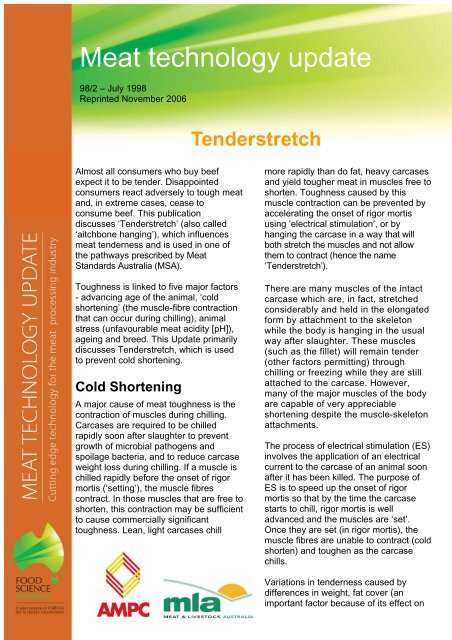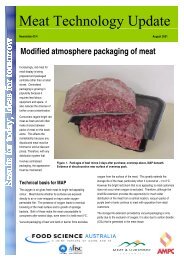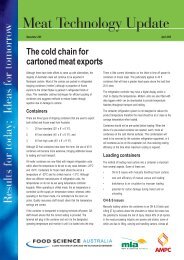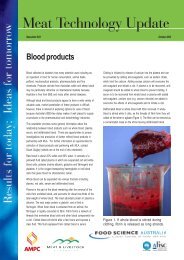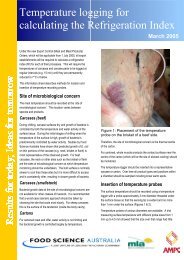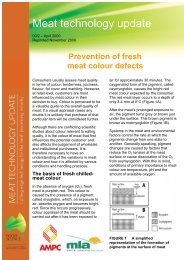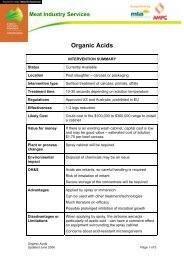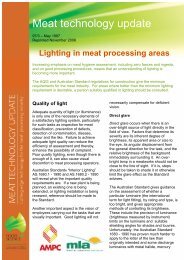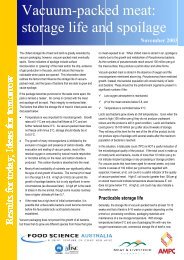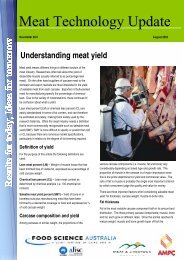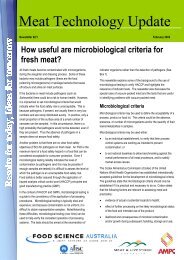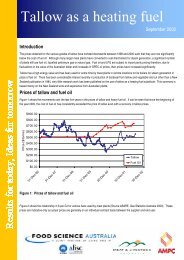Tenderstretch - March 1998 - Red Meat Innovation
Tenderstretch - March 1998 - Red Meat Innovation
Tenderstretch - March 1998 - Red Meat Innovation
Create successful ePaper yourself
Turn your PDF publications into a flip-book with our unique Google optimized e-Paper software.
<strong>Meat</strong> technology update98/2 – July <strong>1998</strong>Reprinted November 2006<strong>Tenderstretch</strong>Almost all consumers who buy beefexpect it to be tender. Disappointedconsumers react adversely to tough meatand, in extreme cases, cease toconsume beef. This publicationdiscusses ‘<strong>Tenderstretch</strong>’ (also called‘aitchbone hanging’), which influencesmeat tenderness and is used in one ofthe pathways prescribed by <strong>Meat</strong>Standards Australia (MSA).Toughness is linked to five major factors- advancing age of the animal, ‘coldshortening’ (the muscle-fibre contractionthat can occur during chilling), animalstress (unfavourable meat acidity [pH]),ageing and breed. This Update primarilydiscusses <strong>Tenderstretch</strong>, which is usedto prevent cold shortening.Cold ShorteningA major cause of meat toughness is thecontraction of muscles during chilling.Carcases are required to be chilledrapidly soon after slaughter to preventgrowth of microbial pathogens andspoilage bacteria, and to reduce carcaseweight loss during chilling. If a muscle ischilled rapidly before the onset of rigormortis (‘setting’), the muscle fibrescontract. In those muscles that are free toshorten, this contraction may be sufficientto cause commercially significanttoughness. Lean, light carcases chillmore rapidly than do fat, heavy carcasesand yield tougher meat in muscles free toshorten. Toughness caused by thismuscle contraction can be prevented byaccelerating the onset of rigor mortisusing ‘electrical stimulation’, or byhanging the carcase in a way that willboth stretch the muscles and not allowthem to contract (hence the name‘<strong>Tenderstretch</strong>’).There are many muscles of the intactcarcase which are, in fact, stretchedconsiderably and held in the elongatedform by attachment to the skeletonwhile the body is hanging in the usualway after slaughter. These muscles(such as the fillet) will remain tender(other factors permitting) throughchilling or freezing while they are stillattached to the carcase. However,many of the major muscles of the bodyare capable of very appreciableshortening despite the muscle-skeletonattachments.The process of electrical stimulation (ES)involves the application of an electricalcurrent to the carcase of an animal soonafter it has been killed. The purpose ofES is to speed up the onset of rigormortis so that by the time the carcasestarts to chill, rigor mortis is welladvanced and the muscles are ‘set’.Once they are set (in rigor mortis), themuscle fibres are unable to contract (coldshorten) and toughen as the carcasechills.Variations in tenderness caused bydifferences in weight, fat cover (animportant factor because of its effect on
cooling rate), the position of the carcases inthe chillers, and the temperatures in thechillers, are eliminated by the use of ES. Allof these factors would otherwise affect thechilling rate, cause shortening of manyexpensive cuts and, therefore, affect theirtenderness.Electrical stimulation is available to achieve apH and temperature relationship within theMSA window for various rates of chilling.<strong>Tenderstretch</strong>In this method, many of the valuable musclesof a carcase are restrained and preventedfrom cold shortening during the rigor processby changing the suspension point of the sidefrom the achilles tendon to the sacrosciaticligament (the thick ligament around theanus), or to the eye of the aitchbone(obturator foramen). For whole carcases,suspension is from the pelvic girdle.This process leads to a tendernessimprovement in most of the commerciallyimportant primal cuts, e.g. rump, thick flank,topside, silverside, striploin and cube roll, butnot the blade.All dressing procedures are carried outnormally on the carcase suspended from theachilles tendon. Transfer of the beef sidesuspension point to the ligament oraitchbone can be carried out at any pointproviding it is done within one-and-a-halfhours of sticking. The equipment required forFigure 1: Transfer procedure; Achilles tendon to aitchbone2
transfer is minimal, consisting of extended ‘S’hooks, a 1/4-tonne capacity electric hoist anda high-level work platform. Suggested detailsof the transfer procedure are given in Figure1. A suggested on-line procedure is shown inFigure 2.Suggested details of the ‘S’ Hook aregiven in Figure 3.The sides must be left hanging, suspendedby the ligament or aitchbone, for at least 20hours or until rigor mortis is established.After this period, the side or quarter can behung again by the achilles tendon.An indication of the improvement intenderness in beef is shown in Figure 4.Ageing of <strong>Tenderstretch</strong> meat effectivelyincreases the degree of tenderness overaged conventionally hung meat.Improvements in tenderness followingageing occur more rapidly in meat which istenderstretched than in that which isconventionally hung. The findings from arecent Cooperative Research Centre (CRC)experiment supported those of earlierCommonwealth Scientific & IndustrialResearch Organisation (CSIRO) research -that ageing beyond seven days for3
<strong>Tenderstretch</strong> carcases will result innegligible improvement in tenderness.The MSA window requires aged<strong>Tenderstretch</strong> for some cattleproduction systems.Cooking loss in tenderstretched meatis less than that in conventionallyhung meat.Similar improvements in thetenderness of the commerciallyimportant primal cuts in sheep andlamb carcases are obtained byhanging the hot carcases from thepelvic girdle.<strong>Tenderstretch</strong> also introduces twodistinct side/carcase changes. It yieldssides/carcases with the hind leg(s)protruding at about right angles fromthe backbone (compared with thereasonably symmetrical hangingposition achieved with conventialachilles-tendon-suspension); and itchanges the shape of some cuts, thusrequiring a modified boning technique.Contact us for additional information<strong>Meat</strong> Industry Services is supported by the Australian <strong>Meat</strong> Processor Corporation (AMPC) and <strong>Meat</strong> & Livestock Australia (MLA).Brisbane: Sydney: Adelaide:Food Science Australia Bill Spooncer Chris SentancePO Box 3312 PO Box 181 PO Box 178Tingalpa DC QLD 4173 KURMOND NSW 2757 FLAGSTAFF HILL SA 5159Ian Eustace Neil McPhail Alison SmallT +61 7 3214 2117 T +61 7 3214 211 T +61 7 3214 2109 T +61 2 4567 7952 T +61 8 370 7466F +61 7 3214 2103 F +61 7 3214 2103 F +61 7 3214 2103 F +61 2 4567 8952 F +61 8 8370 7566M 0414 336 724 M 0414 336 907 M 0409 819 998 M 0414 648 387 M 0419 944 022


